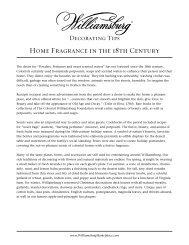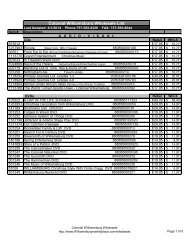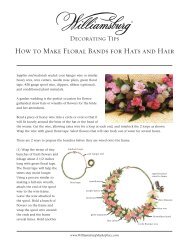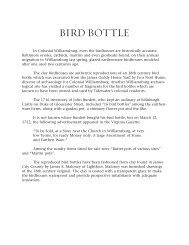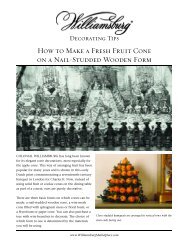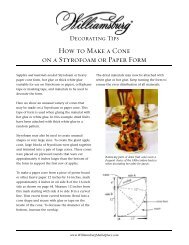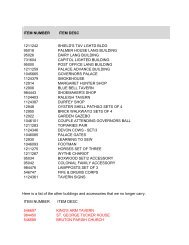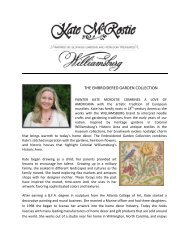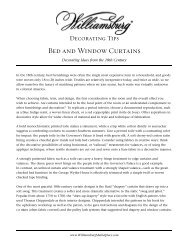Bird Bottle Instructions - Williamsburg Marketplace
Bird Bottle Instructions - Williamsburg Marketplace
Bird Bottle Instructions - Williamsburg Marketplace
You also want an ePaper? Increase the reach of your titles
YUMPU automatically turns print PDFs into web optimized ePapers that Google loves.
BIRD BOTTLE<br />
In Colonial <strong>Williamsburg</strong>, even the birdhouses are historically accurate.<br />
Baltimore orioles, catbirds, martins and even grosbeaks found, on their annual<br />
migration to <strong>Williamsburg</strong> last spring, glazed earthenware birdhouses modeled<br />
after one used two centuries ago.<br />
The clay birdhouses are authentic reproductions of an 18th century bird<br />
bottle which was excavated from the James Geddy House Yard by Ivor Noel Hume,<br />
director of archaeology for Colonial <strong>Williamsburg</strong>. Another <strong>Williamsburg</strong> archaeological<br />
site has yielded a number of fragments for the bird bottles which are<br />
known to have been owned and used by Tidewater’s colonial residents.<br />
The 1716 inventory of John Burdett, who kept an ordinary at Edinburgh<br />
Castle on Duke of Gloucester Street, included “16 bird bottles” among the earthenware<br />
items, along with a garden pot, a chimney flower pot and the like.<br />
It is not known where Burdett bought his bird bottle, but on March 12,<br />
1752, the following advertisement appeared in the Virginia Gazette:<br />
“To be Sold, at a Store near the Church in <strong>Williamsburg</strong>, at very<br />
low Terms, for ready Money only, A large Assortment of Stone<br />
and Earthen Ware.”<br />
Among the sundry items listed for sale were “Butter pots of various sizes”<br />
and “Martin pots”.<br />
The reproduced bird bottles have been fashioned from clay found in James<br />
City County by James E. Maloney of Lightfoot. Maloney was furnished drawings<br />
of the 18th century original. The clay is coated with a transparent glaze to make<br />
the birdhouses waterproof and provide prospective inhabitants with adequate<br />
insulation.<br />
<strong>Bottle</strong> <strong>Bird</strong>houses Handcrafted<br />
at<br />
<strong>Williamsburg</strong> Pottery
XXXX<br />
XX<br />
XXXX<br />
XX<br />
Use a large headed nail or screw to hang the<br />
back opening of the bird bottle on.<br />
A twig is inserted to form the perch.<br />
Helpful Hints:<br />
• Do not hang in an area that receives full sun<br />
• East or west facing locations are best – walls that face south should not be used<br />
due to the amount of sun the location would receive. This can result in heat<br />
build-up within the bottle.<br />
• Placing a perch in the bottle can actually be detrimental to smaller birds<br />
attempting to create a nest. The perch can enable larger birds to gain easy<br />
access and destroy the nest.<br />
• As with any nest box or feeder, it is helpful to place it near trees or shrubs to<br />
provide cover.<br />
• If the bird bottle does not become inhabited in a year or so, consider trying new<br />
locations until you find one suitable to you and your birds.



